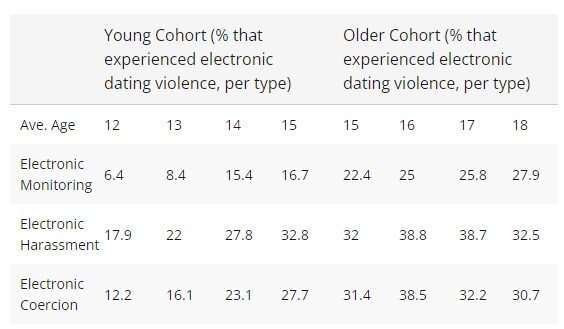E-violence increases through early adolescence but declines as teens become adults

Electronic dating violence—including electronic harassment, coercion and monitoring—starts increasing in preadolescence but curves as teens reach young adulthood, according to a new University of Michigan study.
The study looked at the three behaviors in students in two age groups (12–15 and 15–18) to determine how they experienced electronic dating violence. Electronic harassment includes messaging, calling and sending other items to illicit compliance via intimidation and fear tactics; electronic coercion is pressuring a partner to share sexual or illicit messages, pictures or videos; and electronic monitoring is the viewing, listening or reading of messages, images or videos of one's partner.
"We found that at age 12, youth are at risk of engaging in all three forms of electronic dating violence that we studied, and that between 9th and 10th grade—when youth are 15 to 16 years old—the risk of all three domains increases substantially. But we see that risk becomes somewhat constant or perhaps even declines after age 16," said Elyse Thulin, a doctoral candidate at U-M's School of Public Health, noting that more research is needed to understand the undercurrents of this decline.
"This corresponds to a developmental shift and adolescents getting more autonomy; once an adolescent can drive they can go be in person with their girlfriend or boyfriend, so it might be that these behaviors increase within in-person interactions, which is why we see a flattening out or potentially even a decrease by age 18 of the electronic behaviors."
Thulin and colleagues used data from the longitudinal Strengthening Healthy Adolescent Relationships and Environments Study, for which data was collected between 2013 and 2017 from 1,236 youth. They looked at predictors that included dating behaviors, drug and alcohol use, adverse childhood experiences, parental monitoring, parental knowledge of electronic accounts and passwords, social support, gender and age.
Among the younger cohort grades 6 through 9 (ages 12–15), they found that all three forms of electronic violence increased across time. Electronic harassment increased from 18% to 33%; electronic coercion from 12% to 28%; and electronic monitoring from 6% to 8%.
When looking at the older cohort, ages 15–18, researchers found the older adolescents reported the greatest engagement in electronic harassment, coercion and monitoring.
But the trajectory over time looked a lot different. In 9th grade, 32% reported electronic harassment, which peaked in 10th grade at 38.8%, declining to 32% in 12th grade. And for electronic coercion, which started at 31% in 9th grade and increased to 39% in 10th grade, declined to 32% in 11th grade and 31% in 12th grade.
"The online space is ubiquitous," Thulin said. "It's an important place where teens are going to connect with each other, going to learn new things, where they're getting entertainment, playing games, so it's really important that we capture some of the risks that come along with that space and we need to capture them within a developmental framework because adolescence is a developmental period where a lot of changes happening."

Provided by University of Michigan





















